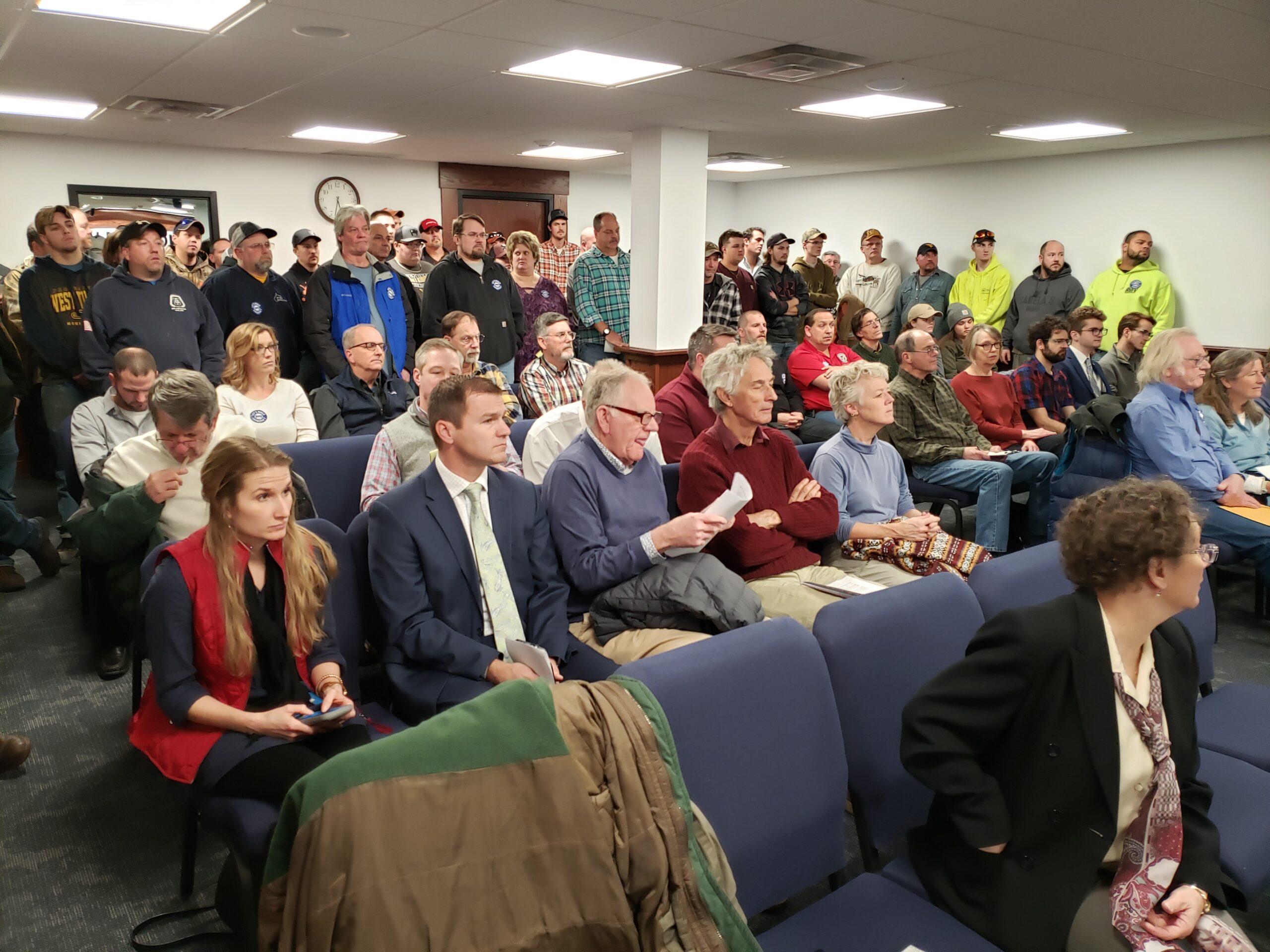MORGANTOWN — More than 75 people jammed the Monongalia County Commission chamber Monday evening for a public comment hearing on the proposed new Longview Power plants – one gas-fired, one solar.
The vast majority were members of the North Central West Virginia Building and Construction Trades Council who turned out in force to support the projects. Only 13 people spoke: five in favor, seven against, one neutral but offering some cautions.
The state Public Service Commission held the hearing as part of its consideration of siting certificate requests submitted by Longview Power II and Longview Renewable Power, daughter companies of Longview Power, which operates the existing coal-fired plant near Maidsville. Longview II will operate the gas-fired plant; Longview Renewable, the solar.

PSC approval will allow the companies to build and operate the two facilities and a high-voltage transmission line.
The overall turnout somewhat reflects the consensus of written comments submitted so far to the PSC: 102 in support, six against.
All but two of the opponents spoke previously at a press conference held before the hearing (see related story).
J. Aultman-Moore of Westover was one of those who hadn’t spoken at the press conference. He supports construction of the solar facility, but not the gas-fired plant, on environmental grounds.
“It’s a horrible idea,” he said. He works in Waynesburg, Pa., where the fracking industry clogs the roads and dirties the air and water. “I just don’t think we want to go this way.”
John Bird, of Masontown, and chair of the Mon Group Executive Committee of the Sierra Club West Virginia, talked about greenhouse gas emissions, global warming, and Longview II’s lack of carbon capture technology. “Without carbon capture, I don’t think this plant should be built.”

Kelley Allen, with the West Virginia Center on Budget & Policy, said she wasn’t speaking for or against the proposals, but offering some cautions about Payment in Lieu of Taxes (PILOT) agreements.
Longview Power is negotiating a Payment in Lieu of Taxes agreement for the two plants with Monongalia County that would provide the county with about $58.2 million across 30 years. WVCBP estimates that the county will give up about $217 million in taxes over those 30 years if it taxed the plants at full value or if the acreage was put to other uses.
She recommend that any PSC approval come with several conditions: disclosure by the county of estimated tax income it will forego through the PILOT; school board agreement to the projects’ a third-party cost-benefit analysis; and an analysis of whether the current coal-fired plant pilot has been successful.
Among those supporting the project was Jason Harshbarger, state policy director for Dominion Energy. He said building Longview II is part of the natural next step in West Virginia’s progress in participating in the Marcellus-Utica shale boom. Our neighbors are already far ahead in building and operating gas0fired plants.
The technology behind Longview II is groundbreaking and will provide a global model for clean fossil fuel power, he said. Combined, the three facilities will power more than 2 million homes in the area.
Building Trades Council Secretary Natalie Stone spoke for the dozens of members standing in the back and around the sides of the chamber. Longview Power has committed to using local labor, she said. The jobs will provide good wages and benefits and will be good not only for the workers but also the local businesses they’ll patronize.
Daniel Warnick is a former miner who now works at the Longview plant. “As a single dad, they provide me with excellent wages and benefits,” he said. The plant is the cleanest coal-fired plant in the country and they verify their emissions measurements with third-party testing. “Management constantly challenges us to do better.”
Russ Rogerson is president and CEO of the Morgantown Area Partnership. He contradicted comments about the county sacrificing tax dollars, noting that the property is currently not in use and generating no significant taxes, so the PILOT represents money gains, not lost.
Case background
The two companies filed their application with the PSC last September.
Longview II would be a 1,200 megawatt powered by two high-efficiency, low-heat-rate gas turbines and occupying about 54 acres north of the existing plant. Longview Renewable will consist of three solar panel array fields generating about 70 MW of power: 20 MW in the West Virginia array also near the existing plant, and 50 MW just across the Pennsylvania border. The total array will cover 70 acres, with a planned fourth array in West Virginia bringing the total acreage to 127.
Longview Power President and CEO Jeff Keffer told the PSC in written testimony that Longview Ii construction will produce about 4,947 job years 9equivalent ot one full-time job for one person for a year) and $363 million in wages. During its first year in operation, it will produce about 619 full- and part-tie jobs with $43 million in wages.
Solar facility construction will produce 75 job years and $4.5 million in wages. During its first year in operation, it would provide 10 full- and part-time jobs and $640,000 in wages.
Annual county revenue from the proposed PILOT – which hasn’t been finalized – is projected at $2.5 million up front, then gradually escalating from $1.58 million for the first five years up to $2.47 million in year 30.
The two new facilities would sell power into the regional electric grid – PJM Interconnect.
Explaining why the plants are needed, Keffer told the PSC, “The landscape of electricity generation is changing and the project represents progress in terms of modernizing West Virginia’s generating fleet.”
Coal-fired plants are phasing out, he said. Since 2011, 25,537 MW of coal capacity has been retired and another 6,949 MW will go offline by the end of 2022.
“With so much coal-generated capacity going offline,” he said, “other generation is needed to replace it to ensure the reliability of the electric grid.”
Tweet David Beard @dbeardtdp Email dbeard@dominionpost.com




